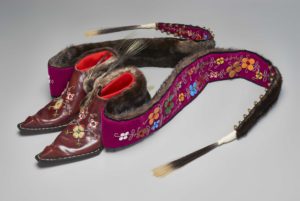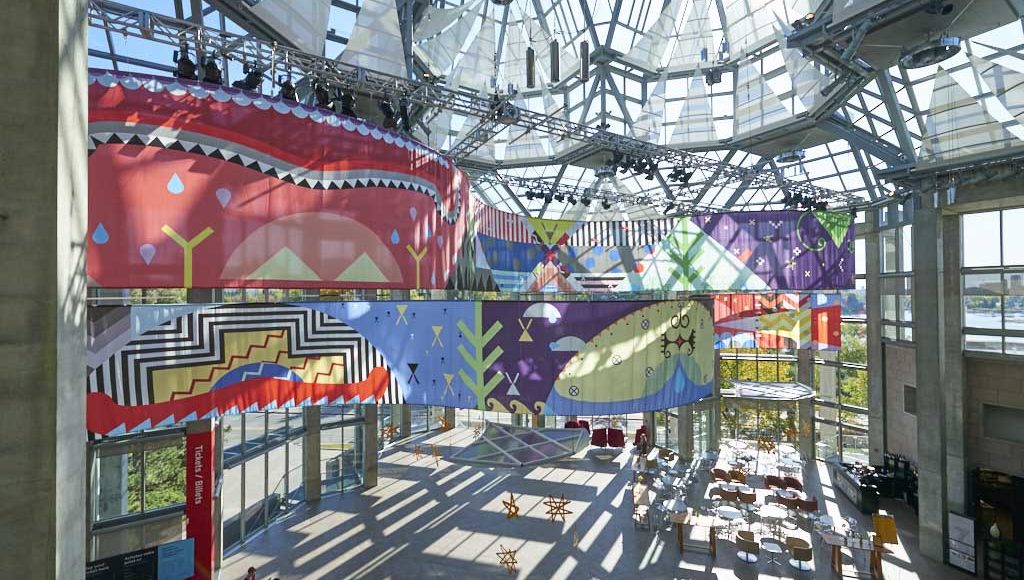Àbadakone means “continuous fire,” in the Anishinaabemowin language, but as the title of the new exhibition at the National Gallery it could as well mean to give joy, to embrace, to be immersive, and to be big — at times, very big.
Àbadakone (it’s pronounced “AH-bada-kwanay”) — is the gallery’s second quinquennial (pronounced . . . uh, you’ll have to figure that one out on your own). Like Sakahàn in 2013, it’s a global survey of contemporary Indigenous art, and it’s marked by ambition and scale. It includes more than 100 works by some 70 artists from 16 countries, and representing 40 distinct indigenous cultures, here expressed in a wide variety of media and styles. Most of the artists are exhibiting at the gallery for the first time.
To say it’s big is no exaggeration. Immediately inside the gallery’s main entrance is Sámi Architectural Library, by Joar Nango, a Sámi artist and architect from northern Norway. It’s a library and an artist’s workshop, built on site as a commission for the exhibition.

Laakkuluk Williamson Bathory andJamie Griffiths. Silaup Putunga Iluani [Inside the Hole in the Universe / Une brèche dans l’Univers], 2018. © Laakkuluk Williamson Bathory and Jamie Griffiths. Photo: Jamie Griffiths
Much of the exhibition’s best (and biggest) is commissioned work. Ottawa-based Joi T. Arcand has adorned the long ramp that leads up to the exhibition spaces with words of “hope and encouragement” written in Plains Cree. The letters will be indecipherable to most, but their hot pink and neon green colours are universally engaging.
At the top of the ramp, hung from the glass ceiling in the Great Hall, is Newfoundland Mi’kmaq artist Jordan Bennett’s Tepkik. The installation — think of a massive mobile — is inspired by Mi’kmaq petroglyphs and quillwork, and by a galaxy of ancestral cosmology. It must be among the largest works ever exhibited inside the gallery. (Perhaps the iceberg built by Greenlandic artist Inuk Silis Høegh for Sakahan was larger, but it was outside, atop the Great Hall.)
There’s more large-scale work to see before you enter the main exhibition space. A wall in the corridor leading away from the Great Hall is covered in four large canvases that were painted on site by the Tribal Women Artists Co-operative, from Hazaribagh, India. Motifs from ancient rock painting merge with contemporary styles in a menagerie of joyful creatures, summoned to defend the rights of women, and their territories, against modern environmental degradation.

Mata Aho Collective.
AKA, installed at the National Gallery of Canada, 2019. Collection of the Collective. © Mata Aho Collective. Photo: NGC
At the end of the corridor is a huge column of the blue-green colour you might see in the shallows of a tropical sea. It was handwoven from marine rope by the Maori women of the Mata Aho Collective in Aotearoa, New Zealand, and to stand at its foot and look upward is to feel both small and uplifted.
The curatorial team of Àbadakone — led by the gallery’s own Rachelle Dickenson, Greg Hill and Christine Lalonde, with Candice Hopkins, Ariel Smith, Carla Taunton and others — literally had a world of art to choose from, and what a thrilling and challenging task that must have been. The variety and quality of work in the exhibition speaks loudly to the strength of indigenous art worldwide, and to how ancient cultures and modern issues are interwoven seamlessly and effectively.
There are spectacular examples of what the exhibition notes call “a kind of cultural armour,” including British Columbia Tahltan and Tlingit carver Dempsey Bob’s Wolf Warrior Helmet, or New Mexico Diné photographer Will Wilson’s portrait of “K’ómoks Imperial Stormtrooper (Andy Everson),” with its surprisingly harmonious mix of traditional Kwakwaka’wakw design and a Star Wars helmet.
There are works that echo familiar parts of the gallery’s permanent collection: South African Hlubi photographer Siwa Mgoboza’s intensely coloured costumes are a match for American artist Nick Cave’s “sound suits” (one of which is in the gallery’s permanent collection). Mgoboza’s photographs also share a flamboyance with the vibrant trousers and backgrounds in Benin Goun artist Leonce Raphael Agbodjélou’s photographs of bodybuilders.

Barry Ace (Anishinaabe). Born 1958, M’Chigeeng, ON. Lives and works in Ottawa. Nigik Makisinan (Otter Moccasins) 2014. Shoes, otter pelt, velvet fabric, electronic components, synthetic porcupine bristles, deerhide, synthetic felt, copper beads, brass bells. National Gallery of Canada. Purchased 2017.
There are traditional materials, such as beads, seen in Ottawa Anishinaabe artist Barry Ace’s fantastical “trail duster” moccasins, or in Saskatoon Cree artist Ruth Cuthand’s recreation of laboratory cultures of smallpox, pneumonia and Spanish flu.
Perhaps most engaging are the opportunities to become immersed in the installations. Marianne Nicolson, a Dzawada’enuxw Kwakwaka’wakw artist from B.C., built a glass box covered in traditional images and illuminated from within. The shadows of the images move slowly outward from the box and climb the walls — and you, if you’re standing in the darkened room — like the inexorable flood waters that beset Nicolson’s community in 2010, a consequence of logging and climate change, she asserts.
Nearby is Montreal Kanien’keha:ka and Italian artist Skawennati’s We Extend the Rafters. Inside, you stand before a screen that shows cyber animation of Haudenosaunee cultural themes, inside a longhouse built of a skeletal frame that embraces you like a ribcage. It feels as if you’ve been welcomed into the very body of the community, an effect something like that of Louise Bourgeois’ Maman, the giant spider outside the gallery’s front door.

Caroline Monnet (Algonquin and French) Born 1985, Ottawa. She now lives and works in Montreal. Transatlantic (video still) 2018. Video, 15 minutes. Courtesy National Gallery of Canada, purchased 2019. With permission of the artist.
There’s another kind of intimacy in the video installation from the Ottawa-born Algonquin and French artist Caroline Monnet. A fixed camera on the bow of a cargo ship recorded the journey from Europe to North America, a route “layered with colonial histories…” Between the viewing area and the large, horizontal screen sit five large, concrete spheres, and it is their immobility that somehow creates a real sense of motion in the viewer as the seas roll and swell.
This is a big exhibition dominated by big installations, though even its smallest parts are eloquent. Evgeniy Salinder, a Nenets artist from Siberia, has 27 people and animals carved from antler or ivory or even fossil, and decorated with leather and bone. To the far left of the cabinet is a tiny figure, perhaps the tiniest of them all, of a man holding a set of antlers atop his own head. It’s barely an inch tall, yet its voice is heard strongly in this chorus of global indigenous culture.
Àbadakone continues to April 5.







